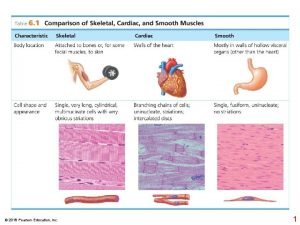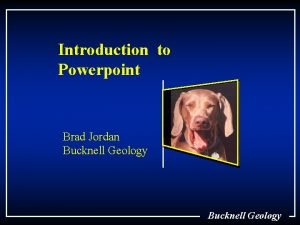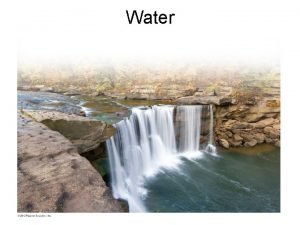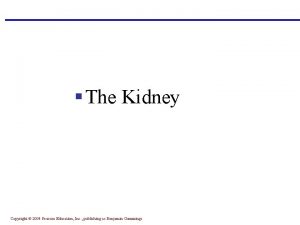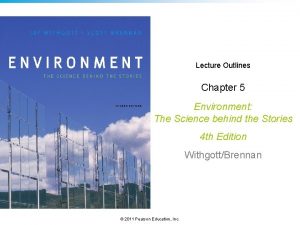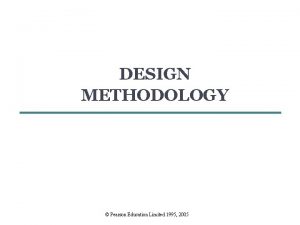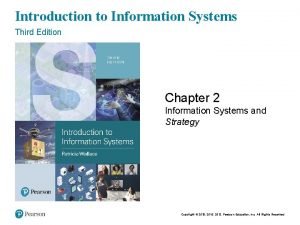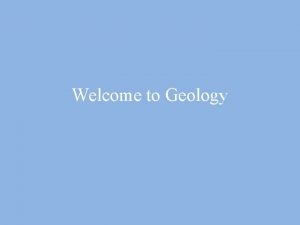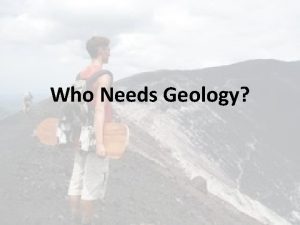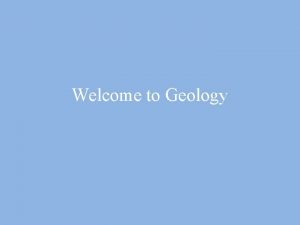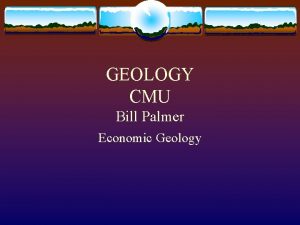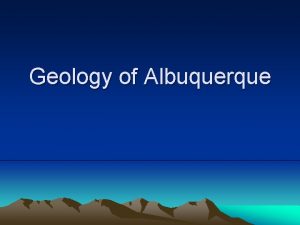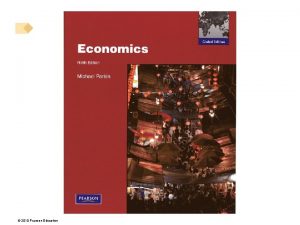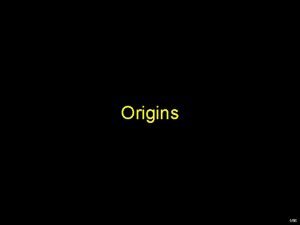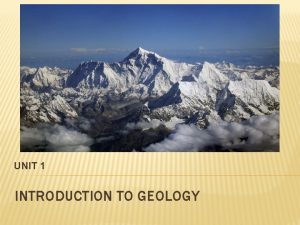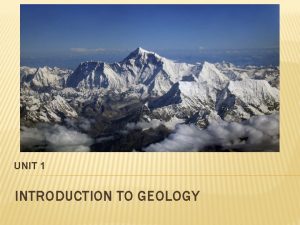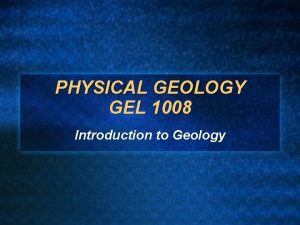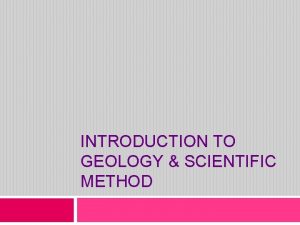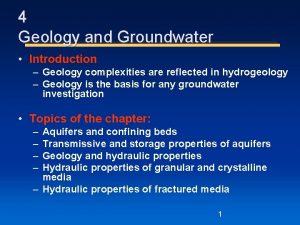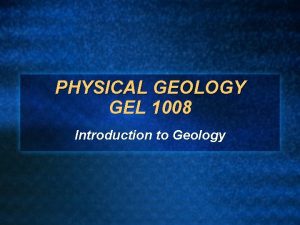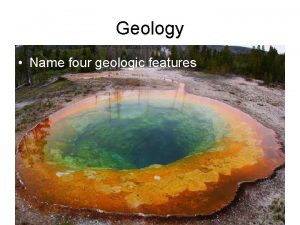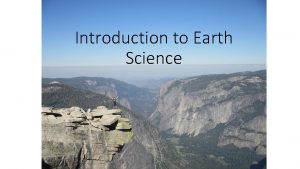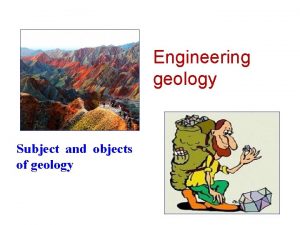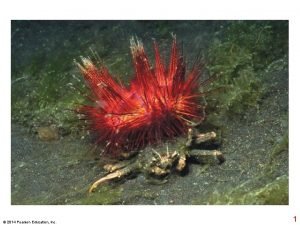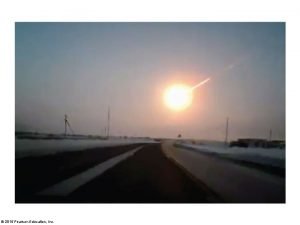Chapter 1 Introduction to Geology 2018 Pearson Education


























- Slides: 26

Chapter 1: Introduction to Geology © 2018 Pearson Education, Inc.

Outline • • Geology: The Science of Earth Development of Geology The Nature of Scientific Inquiry Earth as a System Origin and Early Evolution of Earth’s Internal Structure Rocks and the Rock Cycle The Face of Earth © 2018 Pearson Education, Inc.

1. 1 Geology: The Science of Earth • Geology is the science that pursues an understanding of planet Earth. – Physical geology examines the materials composing Earth and seeks to understand the many processes that operate beneath and upon its surface. – Historical geology seeks an understanding of the origin of Earth and its development through time. © 2018 Pearson Education, Inc.

1. 1 Geology: The Science of Earth (cont. ) • Geology, people, and the environment – There are many important relationships between people and the natural environment. – Some of the problems and issues addressed by geology involve natural hazards, resources, world population growth, and environmental issues. • How are we affecting the environment? © 2018 Pearson Education, Inc.

1. 1 Geology: The Science of Earth (cont. ) • Some historical notes about geology – The nature of Earth has been a focus of study for centuries. – Catastrophism – Uniformitarianism and the birth of modern geology © 2018 Pearson Education, Inc.

1. 2 The Development of Geology • Geologists are now able to assign fairly accurate dates to events in Earth history • Relative dating and the geologic time scale – Relative dating means that dates are placed in their proper sequence or order without knowing their age in years. • Radiometric dating uses radioactive decay to determine an age in years • The magnitude of geologic time – Involves vast times: Millions or billions of years – An appreciation for the magnitude of geologic time is important because many processes are gradual. © 2018 Pearson Education, Inc.

The Geologic Time Scale © 2018 Pearson Education, Inc.

Magnitude of Geologic Time © 2018 Pearson Education, Inc.

1. 3 The Nature of Scientific Inquiry • Science assumes the natural world is consistent and predictable. • The goal of science is to discover patterns in nature and use the knowledge to make predictions. • Scientists collect facts through observation and measurements. © 2018 Pearson Education, Inc.

1. 3 The Nature of Scientific Inquiry (cont. ) • How or why things happen are explained using a – Hypothesis: A tentative (or untested) explanation – Theory: A well-tested and widely accepted view that the scientific community agrees, best explains certain observable facts. • Scientific method – Scientific method involves gathering facts through observations and formulation of hypotheses and theories. • There is no fixed path that scientists follow that leads to scientific knowledge. © 2018 Pearson Education, Inc.

1. 3 The Nature of Scientific Inquiry (cont. ) © 2018 Pearson Education, Inc.

1. 4 Earth as a System • Earth is a planet that is small and self-contained. • Earth’s four spheres – – Hydrosphere Atmosphere Biosphere Solid Earth © 2018 Pearson Education, Inc.

1. 4 Earth as a System (cont. ) • Earth is a dynamic planet with many interacting parts or spheres • Parts of the Earth system are linked • It is characterized by processes that – vary on spatial scales from fractions of a millimeter to thousands of kilometers – have time scales that range from milliseconds to billions of years © 2018 Pearson Education, Inc.

1. 4 Earth as a System (cont. ) • The Earth system is powered by the Sun, which drives external processes – In the atmosphere – In the hydrosphere – At Earth’s surface • The Earth system is also powered from Earth’s interior. – Heat remaining from the Earth’s formation and heat that is continuously generated by radioactive decay powers the internal processes that produce volcanoes, earthquakes, and mountains. © 2018 Pearson Education, Inc.

1. 5 Origin and Early Evolution of Earth • The universe began with the Big Bang 13. 7 billion years ago. • Earth and the other planets formed at essentially the same time out of the same material as the Sun. • The Nebular Theory proposes that the bodies of our solar system evolved from an enormous rotating cloud called the solar nebula. © 2018 Pearson Education, Inc.

1. 5 Origin and Early Evolution of Earth (cont. ) • Nebular Theory – The solar nebula consisted of hydrogen and helium in addition to microscopic dust grains. – A disturbance caused the solar nebula to slowly collapse and rotate. – The solar nebula assumed a flat, disk shape with the protosun (pre-Sun) at the center. – Inner planets began to form from metallic and rocky substances. – Larger outer planets began forming from fragments of ices (H 2 O, CO 2, and others). © 2018 Pearson Education, Inc.

The Nebular Theory Tutorial © 2018 Pearson Education, Inc.

1. 5 Origin and Early Evolution of Earth (cont. ) • Formation of Earth’s layered structure – Metals sank to the center. – Molten rock rose to produce a primitive crust. • Chemical differentiation established the three basic divisions of Earth’s interior (core, mantle, crust). • A primitive atmosphere evolved from volcanic gases. • The earliest primitive crust was lost to erosion and geologic processes. © 2018 Pearson Education, Inc.

1. 6 Earth’s Internal Structure • Earth’s internal layers can be defined by – Chemical composition – Physical properties • Layers defined by composition – Crust – Mantle – Core • Four main layers of Earth are based on physical properties and hence mechanical strength – – Lithosphere Asthenosphere Outer core Inner core © 2018 Pearson Education, Inc.

1. 6 Earth’s Internal Structure (cont. ) Tutorial © 2018 Pearson Education, Inc.

1. 7 Rocks and the Rock Cycle • Illustrates the interrelationships among different parts of the Earth system through various processes. © 2018 Pearson Education, Inc.

1. 8 The Face of Earth • Earth’s surface is divided. © 2018 Pearson Education, Inc.

1. 8 The Face of Earth (cont. ) • Ocean basins – Continental margins • Includes the continental shelf, continental slope, and the continental rise – Deep-ocean basins • Abyssal plains • Oceanic trenches • Seamounts – Oceanic ridge system • Most prominent topographic feature on Earth • Composed of igneous rock that has been fractured and uplifted © 2018 Pearson Education, Inc.

1. 8 The Face of Earth (cont. ) © 2018 Pearson Education, Inc.

1. 8 The Face of Earth (cont. ) • Continents – Mountain belts • Most prominent feature of continents – The stable interior • Shields and stable platforms © 2018 Pearson Education, Inc.

Earth’s Mountain Belts, Stable Platforms, and Shields Tutorial © 2018 Pearson Education, Inc.
 Copyright pearson education inc
Copyright pearson education inc 2018 pearson education inc
2018 pearson education inc Pearson education ltd 2018
Pearson education ltd 2018 Pearson education 2011
Pearson education 2011 Pearson education 2011
Pearson education 2011 Pearson education inc publishing as pearson prentice hall
Pearson education inc publishing as pearson prentice hall 2012 pearson education inc
2012 pearson education inc Copyright 2008
Copyright 2008 Que letra continua m v t m j
Que letra continua m v t m j Introduction to geology ppt
Introduction to geology ppt Bob whelan pearson
Bob whelan pearson Stress management for life 5th edition
Stress management for life 5th edition Water cycle pearson education
Water cycle pearson education Pearson education 2004
Pearson education 2004 Pearson education limited 2008
Pearson education limited 2008 Nitrogen cycle pearson education
Nitrogen cycle pearson education Pearson education limited 2005
Pearson education limited 2005 2017 pearson education ltd
2017 pearson education ltd Pearson education limited 2017
Pearson education limited 2017 2017 pearson education inc
2017 pearson education inc 2017 pearson education inc
2017 pearson education inc 2017 pearson education inc
2017 pearson education inc 2017 pearson education inc
2017 pearson education inc 2017 pearson education inc
2017 pearson education inc Pearson education inc 4
Pearson education inc 4 2015 pearson education inc
2015 pearson education inc 2014 pearson education inc
2014 pearson education inc

